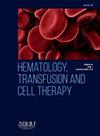Prehospital blood transfusion in Brazil: results of the first year of implementation in an emergency medical service
IF 1.8
Q3 HEMATOLOGY
引用次数: 0
Abstract
Introduction
Hemorrhagic shock is the main cause of death in the prehospital environment, which highlights the need to standardize measures aiming at bleeding control and volume replacement in this environment. In Brazil, the first prehospital packed red blood cell transfusion service started in September 2020, in Bragança Paulista, state of São Paulo.
Objectives
Describe the trends and characteristics of patients who received prehospital transfusions prior to hospital treatment during the first year of operation.
Methods
A retrospective data review was made of all patients who received transfusions from the mobile intensive care unit in Bragança Paulista over one year.
Results
In this period, 19 patients were transfused. Since activation, the average response time was 20 min. The mean shock indexes before and after blood transfusion were 2.16 and 1.1, respectively. During the course of the 1st year of prehospital transfusions, no blood was wasted and there were no adverse effects.
Conclusion
Introduction of the prehospital packed red blood cell transfusion service was successful, with significant improvement in hemodynamic parameters.
巴西的院前输血:在紧急医疗服务中实施第一年的结果。
引言:出血性休克是院前环境中死亡的主要原因,这突出了在这种环境中需要规范旨在控制出血和容量置换的措施。在巴西,第一家院前填充红细胞输血服务于2020年9月在圣保罗州的Bragança Paulista开始。目的:描述手术第一年在医院治疗前接受院前输血的患者的趋势和特征。方法:对所有在BragançA Paulista的移动重症监护室接受输血一年以上的患者进行回顾性数据回顾。结果:在此期间,19名患者接受了输血。自激活以来,平均响应时间为20分钟。输血前后平均休克指数分别为2.16和1.1。在院前输血的第一年中,没有浪费血液,也没有不良反应。结论:院前填充红细胞输注服务是成功的,血流动力学参数显著改善。
本文章由计算机程序翻译,如有差异,请以英文原文为准。
求助全文
约1分钟内获得全文
求助全文
来源期刊

Hematology, Transfusion and Cell Therapy
Multiple-
CiteScore
2.40
自引率
4.80%
发文量
1419
审稿时长
30 weeks
 求助内容:
求助内容: 应助结果提醒方式:
应助结果提醒方式:


